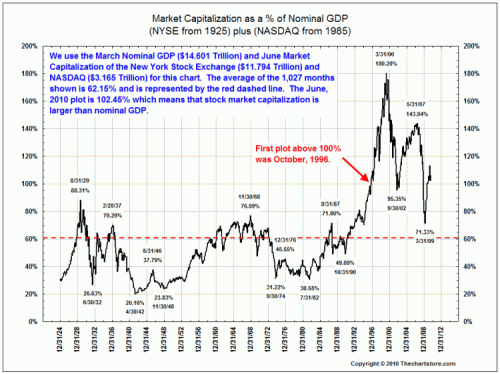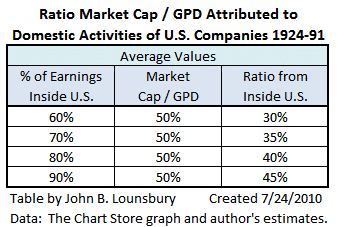Stock Market Capitalization Exceeds GDP
Barry Ritholtz offers this graph (courtesy of The Chart Store).
Barry offers no further comment with the graph, but I started to wonder if the "bubble" in capitalization could be explained by the increase in business done outside the country by U.S. corporations. I have read that about half of the earnings of the S&P 500 companies are derived from activities outside the U.S. It may be that smaller companies do a smaller percentage of business outside the U.S., but let’s use the same 50% estimate for all U.S. firms on average, large and small.
Next, we need to make two additional estimates:
- What was the average capitalization to GDP ratio prior to the globalization era, say before 1992. From the graph I estimate that the ratio from 1924 to 1992 was about 50% (area under the curve method).
- What was the average percentage of business by U.S. corporations done outside the country from 1924 to 1991? That is the second factor that needs to be estimated and I have not at, this point, thought of a good way to get that number. Therefore, I have decided to draw conclusions based on four possible ratios: 40%, 30%, 20% and 10%. I am biased to think that 40% is too high and 10% is too low, but they are included to give outside brackets.
Now we can do some calculations to decide if we actually are in a valuation bubble for U.S. stocks based on historical comparison to GDP.
First half of current earnings are from within the U.S. so half the current total market cap to GDP ratio (~110%) is the reference for "domestic" market cap to GDP ratio, or 55%.
The possible average ratios for 1924 to 1991 are shown in the following table:
It is clear that the ratio of market cap to GDP is currently significantly above historical averages, even when adjustments are made for increased foreign income for U.S. corporations in recent years.
I am not sure what significance to give to this observation. I will make one statement, though: This data should not be put on the list of reasons why the U.S. stock market is undervalued today.


It could be that the US market cap/ GDP could be supported at a higher level because of internationalization of US companies’ operations. It could also be (and there is ample evidence to support this) that US companies are more profitable in their home market when they face weak competition at home from their international peers.
If you offered e.g. IBM the choice of having the US market to themselves, or competing with SAP in both the US and Germany, I’m pretty sure that IBM would go for “protected home market” and pass on their profits from their German subsidiary.
Yet in the 1950’s, a period which probably fits this description pretty well (Volkswagen and Siemens building up from the ashes, IBM with virtually no international competition) we see Mcap/GDP quite low.
Globalization is not a free lunch. US companies cannot open Asian and European branches/ subsidiaries and just rake in money, any more than Asian and European companies can do so in the US.
I would argue that “the globalization era,” which you hilariously guesstimate started in 1992, should bring lower, not higher margins on each dollar of sales and in turn lower returns on each dollar of shareholder equity.
It could be that the US market cap/ GDP could be supported at a higher level because of internationalization of US companies’ operations. It could also be (and there is ample evidence to support this) that US companies are more profitable in their home market when they face weak competition at home from their international peers.
If you offered e.g. IBM the choice of having the US market to themselves, or competing with SAP in both the US and Germany, I’m pretty sure that IBM would go for “protected home market” and happily live wthout profits from their German subsidiary.
Yet in the 1950’s, a period which probably fits this description pretty well (Volkswagen and Siemens building up from the ashes, IBM with virtually no international competition) we see Mcap/GDP quite low.
Globalization is not a free lunch. US companies cannot open Asian and European branches/ subsidiaries and just rake in money, any more than Asian and European companies can do so in the US.
I would argue that “the globalization era,” which you hilariously guesstimate started in 1992, should bring lower, not higher margins on each dollar of sales and in turn lower returns on each dollar of shareholder equity.